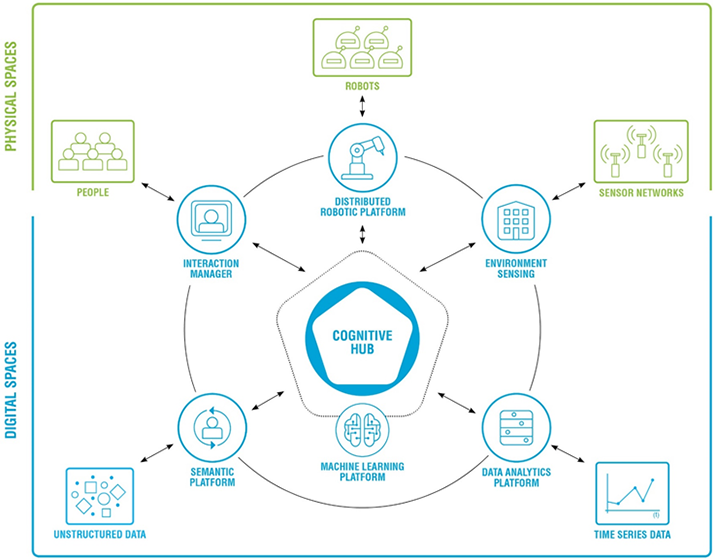Adding One More AI Layer on Connected Technologies
In a workplace world, where connected devices, collected data, and applications overcome the number of people, a call to action is in place to make our future sustainable. The conventional and close straight-line business models – which apply to smart industry too – is indeed becoming unsustainable in the long term. Hence, new intelligent technologies have the power to play a central role to foster a regenerative economic cycle by combining and facilitating the (re)use of data and IoT solutions and orchestrate them into new disruptive services.
We work for creating a cognitive platform to empower people in their workplace by supporting collaboration and enhancing decision processes. Specifically, our research focuses on the i) ingestion of accurate and reliable data from disparate sources via intelligent agents, ii) the extraction of meaningful information from data via an AI layer, and iii) the orchestration of insights via an AI2 layer that enables a set of new disruptive assistive services.
To connect the digital and the physical world (see Figure 1) we are investigating an infrastructure that can orchestrate multiple agents together with AI layers. These investigations focus on different aspects of the existing cloud-edge technologies in order to expand the potential and the quality of services such as smart environment, robotics, and natural language processing with real-time requirements that might be different depending on the context.

Figure 1: Bridging Physical and Digital world through AI.
Particularly, intelligent agents are all those software modules capable to acquire information from devices and their surroundings. Once an agent is connected to our platform, its data is connected via cognitive pipelines to AI engines capable to extract meaningful information; at the same time, data could be stored - according to GDPR and other privacy laws - for further more analysis and for training purposes. At this layer, insights can be provided as the output of the AI engines. For example, an agent connected to a camera could be used as input of an AI activity recognition engine to provide information about activities that are happening in the area covered by that camera.
The AI2 layer collects all the output of AI engines, enriches them with context information, and provides services capable to support collaboration and to enhance decision processes. For example, insights about the camera described above merged with location and other context information can be used to enhance the working experience, e.g., the system can notify an employee, who is trying to move a heavy box, by detecting a potential risk for the person. At the same time, the system could also ask a robot deployed nearby to help the employee with the task. This system can be used to empower employees within different workplaces, from offices to hospitals, to manufacturers.
A lot of technical challenges are still open and need to be addressed, e.g., efficient data processing, resources placement, etc. Moreover, the supplement of Artificial Intelligence layer on the top of existing services has to take into account a number of aspects and has to be designed with the intention to support human autonomy and promotes diversity e.g. by recognizing different contexts and the role played by humans in a specific action. In this direction, the challenge for designing and developing AI is to questioning how AI impacts humans’ lives and leads actions that accommodate routines and automate undermining human activities.
Reinventing the wheel is just something that we cannot afford anymore, in any aspect of our lives. The opportunity intelligent technology is giving us, to enrich and reuse existing data and services, is something we cannot ignore. Hence, the technology we are designing aims at easing the workplace with the expectation to not adding rumor in already noisy smart industries. The integration of different components, devices, platforms, and services is root on the concept that AI will guide and support every aspect of the work-life. Integrating AI and IoT solutions into the workplace is expected to regenerate and refresh the use of data and will generate a set of new disruptive assistive services.
 Riccardo Petrolo is currently R&D Engineer at Konica Minolta Laboratory Europe Rome, Italy. He received Bs.C. and Ms.C. degrees from University “Mediterranea” of Reggio Calabria, Italy in 2010 and 2013 respectively. In 2016, he received the Ph.D. degree from Lille 1 University, France. During this period, Dr. Petrolo served as Research Assistant at Inria Lille – Nord Europe, and he was involved in the development of the EU FP7 VITAL project, one of the first Operating Systems for Smart Cities.
Riccardo Petrolo is currently R&D Engineer at Konica Minolta Laboratory Europe Rome, Italy. He received Bs.C. and Ms.C. degrees from University “Mediterranea” of Reggio Calabria, Italy in 2010 and 2013 respectively. In 2016, he received the Ph.D. degree from Lille 1 University, France. During this period, Dr. Petrolo served as Research Assistant at Inria Lille – Nord Europe, and he was involved in the development of the EU FP7 VITAL project, one of the first Operating Systems for Smart Cities.
In 2015, Dr. Petrolo was Visiting Researcher in the GTA group at UFRJ, Rio de Janeiro, Brazil. From January 2017 to January 2019 he was Postdoc Fellow at Rice University (Houston, Texas, USA) where he led the ASTRO project. His current research interests include the Internet of Things, Robotic Networks, Semantic interoperability, Edge computing, and Smart Cities.
 Teresa Macchia is Design Researcher in Konica Minolta Laboratory Europe. She has ten years’ experience in designing human technologies for private and public sectors. As sociologist and doctor in Computer Science, she is passionate about the impact connected technologies on people lives and she works to design technologies for improving the quality of life. Before joining Konica Minolta Laboratory Europe, she held the position of Experience Researcher at Digital Catapult (UK) and participated in various EU activities through the Unify IoT project, the AIOTI, and the EIT to foster a sustainable and innovative adoption of connected technologies. Teresa received her Ph.D. degree in Computer Science from the University of Trento by focusing on Social Informatics and Human-Computer Interaction.
Teresa Macchia is Design Researcher in Konica Minolta Laboratory Europe. She has ten years’ experience in designing human technologies for private and public sectors. As sociologist and doctor in Computer Science, she is passionate about the impact connected technologies on people lives and she works to design technologies for improving the quality of life. Before joining Konica Minolta Laboratory Europe, she held the position of Experience Researcher at Digital Catapult (UK) and participated in various EU activities through the Unify IoT project, the AIOTI, and the EIT to foster a sustainable and innovative adoption of connected technologies. Teresa received her Ph.D. degree in Computer Science from the University of Trento by focusing on Social Informatics and Human-Computer Interaction.
Sign Up for IoT Technical Community Updates
Calendar of Events
IEEE 8th World Forum on Internet of Things (WF-IoT) 2022
26 October-11 November 2022
Call for Papers
IEEE Internet of Things Journal
Special issue on Towards Intelligence for Space-Air-Ground Integrated Internet of Things
Submission Deadline: 1 November 2022
Special issue on Smart Blockchain for IoT Trust, Security and Privacy
Submission Deadline: 15 November 2022
Past Issues
September 2022
July 2022
March 2022
January 2022
November 2021
September 2021
July 2021
May 2021
March 2021
January 2021
November 2020
July 2020
May 2020
March 2020
January 2020
November 2019
September 2019
July 2019
May 2019
March 2019
January 2019
November 2018
September 2018
July 2018
May 2018
March 2018
January 2018
November 2017
September 2017
July 2017
May 2017
March 2017
January 2017
November 2016
September 2016
July 2016
May 2016
March 2016
January 2016
November 2015
September 2015
July 2015
May 2015
March 2015
January 2015
November 2014
September 2014


